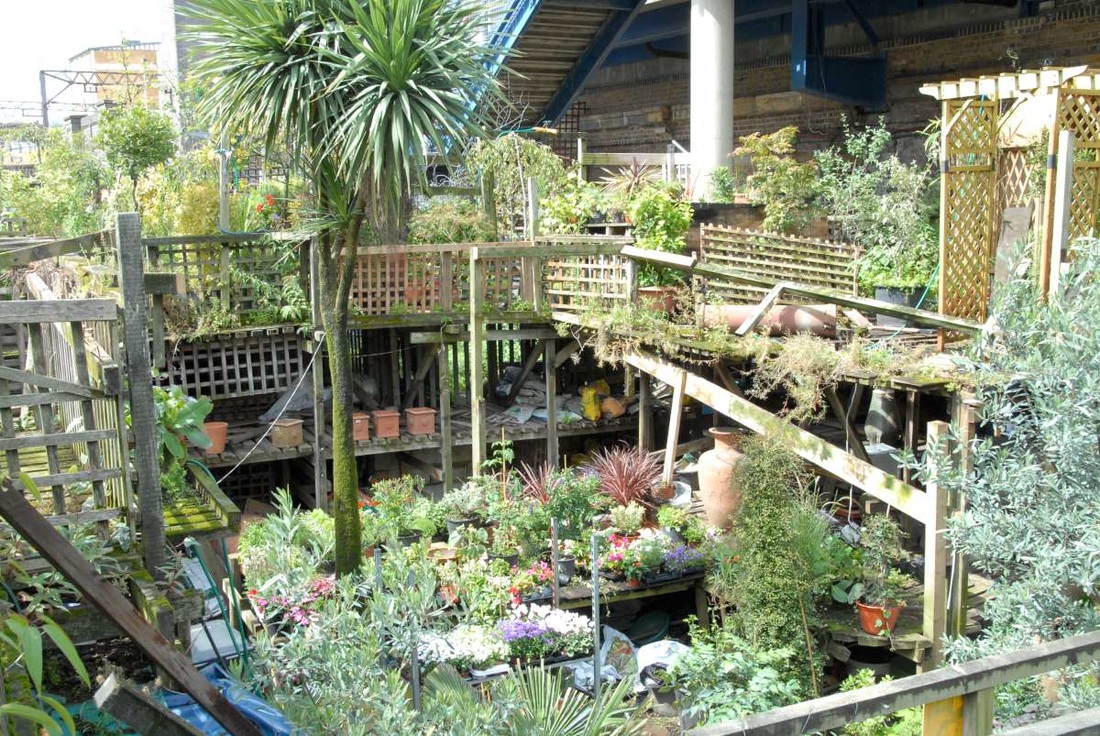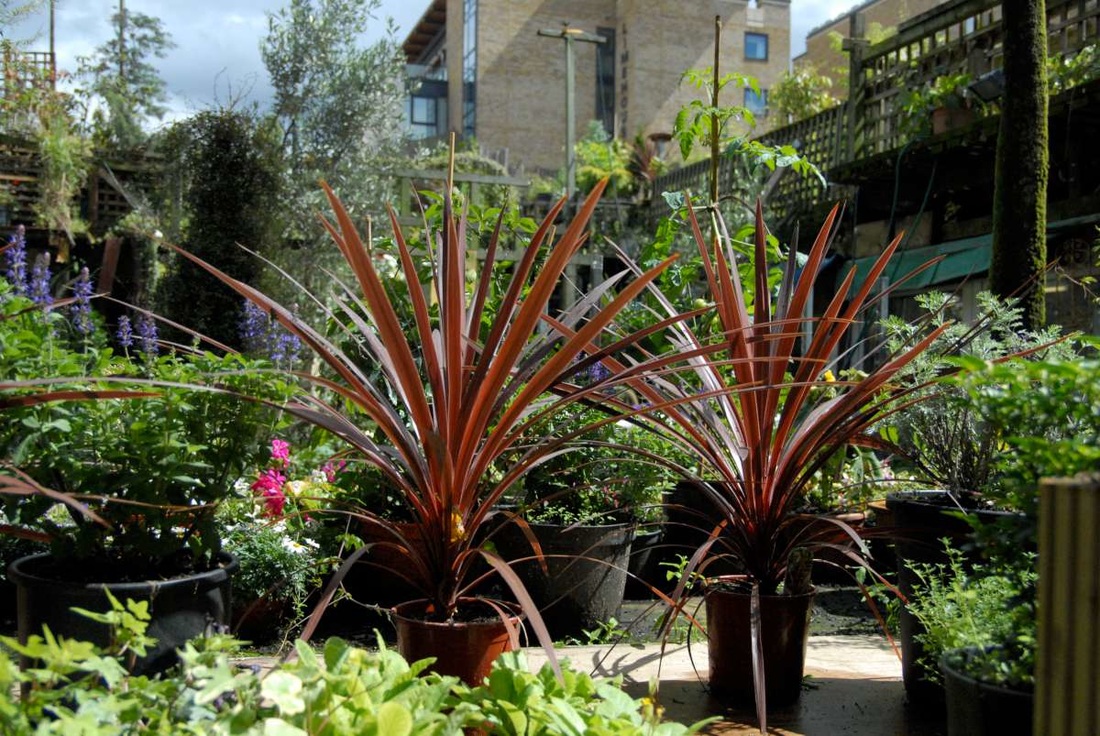London is a pricey place, very pricey. Especially pricey in London is the place itself, in other words the ground beneath your feet. A garden centre usually needs quite a bit of ground. This is why there aren't all that many garden centres in Inner London. But where there is a will and ideas, there is a way - and room is in the smallest of dwellings. Something along theses lines Alan Jarman may have figured when fourteen years ago he converted an area of no more than 50 metres by 20 metres in the midst of London into a garden centre.
Perhaps the nearby skyscrapers of Canary Wharf were an inspiration [At that time the only in London, no Shard etc. then, remember!] but anyway: Alan went up into the air with his plants. The Docklands Garden Centre became an ingenious and elaborate construction of planks, boards, posts, trellis work and fence panels, which allowed for "shop floor" and retail space on several levels thus at least doubling the initial size of 1000 sqm. As a customer or visitor, you had a feeling of being in an Aladdin's Cave: walking around, you would come across a new level, a new room, a new deck which you hadn't expected or would have thought possible time and time again.
Like through a short subway you arrive in an open yard in the middle of the garden centre. Tables there usually spilled over with seasonal and bedding plants, herbs and statement plants for containers. From here you can see that the gateway through which you just passed is part of the labyrinth of balconies, steps, bridges, walkways and decks. High up, in the open where there is natural light, the plants are stood: trees, shrubs, perennials. Reed mats tied to the perimeter of this ingenious construction provide shelter from the wind.
On the lower decks shade plants like ferns have their place. And down below, in the darker corners of the garden centre, there are shelves upon shelves full of clay and terracotta pots, bowls and urns. You’ll find everything from 8 cm pots to containers 1.5 m in diameter. At the very back, where there are stacks of saucers, spider webs weave and it drips through gaps and groves from the watering going on above. It is dim and moist like in a grotto and somehow befitting the feeling of being in an Aladdin's Cave.
And of course there were, on the darker levels at the bottom of the garden centre, soils and composts, sand, gravel, pebbles and grit of different colouring and provenance – by the sack-full or the bagful. And if this was still to much for your needs - because you only had to repot three or four pots on a windowsill - you could fill a small bag with however much or little you thought necessary. Alan, of a 1938 vintage, careful and quirky in a most loveable way, would estimate by rule of thumb and usually made you a very customer friendly price.
Sometime though, Alan inwardly must have given up the fight, must have realized that unfortunately David not always wins out over Goliath. The pressure from not one but two sides grew stronger and stronger. On the one hand, there are the competitors: supermarkets and DIY warehouses, and increasingly the internet, too. Bit by bit they snatched business from him: first pots and trellises, then fertilizer and pesticides, then indoor plants. „They ruin small enterprises“, says Alan. „The margin and wiggle room are no longer there. If the product range on offer is too narrow and small, an enterprise is no longer viable.“ The final straw however came when his landlord increased the rent, from previously £ 16,000 to now £37,000 per annum. How could Alan possibly shoulder that? Where should the money come from?
Quite possible that this quaint garden centre, seeming almost anarchic, was a thorn in the eye of the landlord and some developers. The area is „up and coming“. The old docks have long since turned into oases of leisure, in some of them now anchor expensive yachts instead of merchant vessels. The modern world of Canary Wharf, a kind of metropolis with the concrete and mirrored glass towers of the global banking, media and insurance corporations, is but a stroll away. So Limehouse is a sought-after area to live in for all those employed in that enclave of big business and high finance.
Even the current economic recession means no more than a temporary dent. Wherever you look, new high-rise buildings sprout like mushrooms from the ground. That the Docklands Light Railway trains screech on some stretches of the track that it sends shivers down your spine is no obstacle either: some blocks are built right next to it. In circumstances like these, even a comparatively small plot like that occupied by the garden centre is still lucrative to sell...
It would have to be a miracle of fairy tale-like proportions in any case, if it was still to help: the Docklands Garden Centre is a picture of desolation, decline and decay. The decks and walkways are broken and crashed, the steps are overgrown with mosses and algae, weeds thrive everywhere. In Germany, the whole site quite probably would have been declared a „No entry“–zone on Health and Safety grounds some time ago. But Alan, standing on swinging, unsecured boards with no supporting posts underneath, still ties his fosterlings to canes.
He has given up hope, accepted the way thing run. But he has turned bitter, disappointed surely and sad – the Docklands Garden Centre was his work. In its heyday, thirteen people were employed, between three and five here in the garden centre. The rest would carry out jobs elsewhere. Even today, an elderly lady wants a bed to be laid out and planted with Buzzy Lizzies. Alan sends one of the few remaining staff over.
You want to side with him, agree with him. Because with the garden centre not only another enterprise and livelihoods will go, but another patch of green in an area that doesn’t offer much green in the first place. Looked at with unsentimental eyes though, the Docklands Garden Centre is past it already. Yes, the current economic crisis also sends some developers into bankruptcy, stops many an ambitious building project and drives down prices for a bit. But even if Alan could pay the lease for another two, three years: the effort needed to spruce everything up again is much too big. Because - for how long? The sword of Damocles remains hanging, after all. So this article really is a requiem, an obituary for an extraordinary original garden centre.
P.S. There was, of course, no miracle. The Docklands Garden Centre wound up, closed its doors and was dismantled. Today, more than seven years on, the site is still empty.








 RSS Feed
RSS Feed